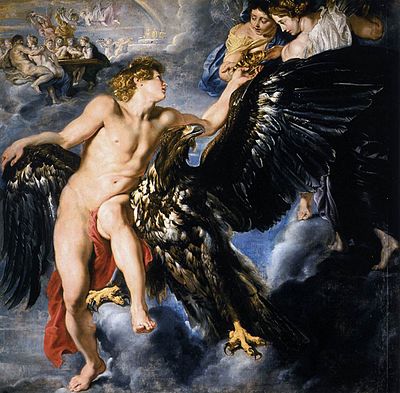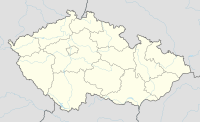User:Schwarzenbergika/sandbox
Privileges
[edit]Knights of the order enjoy a variation of privileges. Some privileges are shared, while others differ due to split of the order in 1700 and their henceforth developed core characteristic. The Spanish order has developed into a state order of merit, while the Austrian order has remained a Catholic order of knighthood with a strong bond of brotherhood.
Heraldry
[edit]Jean-Baptiste Christyn (1630 - 1690) records and codifies the heraldic privilege of golden helmets during his time as Chancellor of Brabant (1687 - 1690). He was considered a leading authority on heraldic law in the Habsburg Netherlands by contemporaries. In his work Jurisprudentia heroica (part 2, page 19) he remarks:
| Latin | English |
|---|---|
| §4 | §4 |
| De aurea quoque galea, quæ undequaque auro illinita eft, & gemmis nitens, ut Cæfarum Regumque capita obtegere folet, quorum non eſt ——— PLEBEIA conectus CASSIDE vultus. fupra ad primum hujus Edicti articulum §. 82. differuimus, eumque folis fupremis Principibus, aut fi non fit recto obtutu, Aurei Velleris Equitibus, & iis, qui titulo particulari eatenus muniti ſunt, propriam effe afferuimus. Et hocitidem in Gallia obtinere vult Moreau Traité des Armoiries de France cap. 5. Philib. Monet Origine & Pratique des Armoiries, quod & affirmat Silveſter à Petra Sancta d.l. cap.70. | Also of the golden helmet, which is on every side gilded with gold, and glittering with jewels, to cover the heads of Caepha and Kings, whose countenance is not ——— in accordance with the first article of this Edict § 82. We postponed it, and with the folly of the noblest princes, or if it was not done properly, the Knights of the Golden Fleece, and to those who had hitherto been protected by a particular title, we brought a proper one. And immediately Moreau wishes to obtain in France the Traité des Armoiries de France chap. 5. Phil. He mentions the Origin and Practice of Armories, which Silvester at Petra Sancta d.l. chapter 70 |
| §5 | §5 |
| Licet itaque Principi, quando ei vifum fuerit, jus aureæ galeæ alicui concedere, atque ita Honorati à defenfione hujus Articuli excipiuntur in Claufula, sonder daer toe eenighen tittel oft recht te hebben: ita ut ii, quibus ea de re titulo vel jure proviſum eft, impunè hoc honore gaudeant, cujus rei unicum & recens exemplum fubnecto: | It is therefore permissible for a prince, when he is alive, to grant the right of a golden helmet to someone, and thus those honored in the defense of this article are received in Claufula, without having any title or right to do so: so that those to whom it is provided by title or right may enjoy this honor without impunity, of which I have furnished a unique and recent example: |
| Mon Cousin. M‘ayant de la part des Roys, Heraults, & Pursuivants d‘armes esté presenté la Requeste cy-jointe, touchant les excés, qui se font au port & usage des armoiries, tymbres, titres, & autres marques d'honneur & de noblesse. J’ay bien voulu vous la remettre, afm d'y pourvoir, en conformité de vos instructions, pour le gouvernement de mes pays de par de là, & selon les Placcarts sur ce emanez, lesquels n'operent pas au regard de ceux, estants munis de titres suffisants, ainsi que j'ay accordé nouvellement à Messire SIMON FIERLANTS en confideration de ses services, & de la qualité de sa charge de Conseiller d'Estat pres de ma personne de pouvoir porter luy Sa posterité, L'HEAUME de ses armoiries D'OR, & autres marques d'honneur, comme par sa patente. Atant mon Cousin nostre Seigneur vous ait en sa fainte garde. De Madrid le 11. de May 1665. paraphé V. V. Signé Philippe: plus bas, Vecquer. A mon Cousin le Marquis de Castel-Rodrigo Gentilhomme de nostre Chambre, de nostre Conseil d'Estat, nostre Conseil d'Estat, nostre Lieutenant, Gouverneur & Capitaine General de nos Pays-bas & de de Bourgogne.Sp | My cousin. Having been presented to me on behalf of the Kings, Heraults, & Pursuivants of arms the attached Request, concerning the excesses, which are made in the wearing & use of coats of arms, stamps, titles, & other marks of honor & of nobility. I was kind enough to give it to you, in order to provide for it, in accordance with your instructions, for the government of my countries from there, & according to the Placcarts on this issue, which do not operate with regard to those, being provided with sufficient titles, as I have recently granted to Messire SIMON FIERLANTS in confidence of his services, & of the quality of his office of State Councilor near my person to be able to bring him His posterity, THE HELMET of his GOLD coat of arms, & other marks of honor, as by his patent. As my cousin, our Lord has you in his gentle guard. From Madrid on May 11, 1665. initialed V. V. Signed Philippe: below, Vecquer. To my Cousin the Marquis of Castel-Rodrigo Gentleman of our Chamber, of our Council of State, our Council of State, our Lieutenant, Governor & Captain General of our Netherlands & of Burgundy.Sp |
The privilege of the golden helmets was based on the practices observed at the chapters of the order.
Form of Address
[edit]The bond of knights within the brotherhood was enforced with the privilege to address each other in writing and when greeting one and another in person with “Mon Cousin”.
Holy Mass and Altar
[edit]Pope Pius X reestablished in 1913 the privilege that Knights of the Austrian Order of the Golden Fleece have the right to deem a location as worthy for holding a Holy Mass. The celebration of a Holy Mass on non sacred ground, e.g. at home, is usually only possible with the permission of the local bishop. Knights may do so without asking for permission.
A derivative privilege from the above mentioned right is the possibility to posses and use a personal, portable altar. This enables a knight to raise an altar wherever he deems it suitable in order to hold a Holy Mass.
The origin of this privilege stems from the middle-age and annulled right to hold the Holy Mass at the sick-bed of a knight.
Project Timeline
[edit]Project Achievement Overview
[edit]| Amount | Rank / Titel | Family Member(s) |
|---|---|---|
| State | ||
| 1 | Minister-President | Felix Schwarzenberg (Austrian Empire) |
| 1 | Vice-Prime Minister | Karl Schwarzenberg (Czech Republic) |
| 2 | Minister of Foreign Affairs | Felix Schwarzenberg (Austrian Empire) Karl Schwarzenberg (Czech Republic) |
| Ambassadors | ||
| Church | ||
 Cardinal Cardinal
|
Friedrich (Titular church: Sant'Agostino) | |
 Archbishop Archbishop
|
Friedrich (Archbishop of Salzburg and Prague) | |
 Bischop Bischop
|
Ernst (Bishop of Győr) | |
| Military | ||
| Generalissimus | ||
| Field Marschall (OF-10) | ||
| Generals (OF-6 to OF-9) | ||
| Senior Officers (OF-3 to OF-5) | ||
| Junior Officers (OF-1 to OF-2) | ||
| Orders | ||
| 18 | Georg Ludwig (1627) Johann Adolf (1650) Ferdinand (1688) Adam Franz (1712) Joseph I. (1732) Johann I. (1782) Josef II. (1808) Karl I. (1809) Adolf (1836) Karl II. (1852) Edmund (1862) Karl III. (1881) Adolf Josef (1889) Karl IV. (1907) Johann (1915) Joseph III. (1951) Karl VI. (1960) Karl VII. (1991) | |
| 2 | Karl I. Edmund | |
|
| ||
Project Trivia
[edit]Eleonore Vampir
SMS Schwarzenberg Helgoland
Artists: Ferdinand Runk, Hamilton, Beethoven etc.
Project Economic Impact
[edit]Bohemian Railway
Schwarzenberg Channel
Project Decendents
[edit]| European style family tree bottom to top (William, Prince of Wales) | ||||||||||||||||||||||||||||||||||||||||||||||||||||||||||||||||||||||||||||||||||||||||||||||||||||||||||||||||||||||||||||||||||||||||||||||||||||||||||||||||||||||||||||||||||||||||||||||||||||||||||||||||||||||||||||||||||||||||||||||||||||||||||||||||||||||||||||||||||||||||||||||||||||||||||||||||||||||||||||||||||||||||||||||||||||||||||||||||||||||||||||||||||||||||||||||||||||||||||||||||||||||||||||||||||||||||||||||||||||||||||||||||||||||||||||||||||||||||||||||||||||||||||||||||||||||||||||||||||||||||||||||||||||||||||||||||||||||||||||||||||||||||||||||||||||||||||||||||||||||||||||||||||||||||||||||||||||||||||||||||||||||||||||||||||||||||||||||||||||||||||||||||||||||||||||||||||||||||||||||||||||||||||||||||||||||||||||||||||||||||||||||||||||||||||||||||||||||||||||||||||||||||||||||||||||||||||||||||||||
|---|---|---|---|---|---|---|---|---|---|---|---|---|---|---|---|---|---|---|---|---|---|---|---|---|---|---|---|---|---|---|---|---|---|---|---|---|---|---|---|---|---|---|---|---|---|---|---|---|---|---|---|---|---|---|---|---|---|---|---|---|---|---|---|---|---|---|---|---|---|---|---|---|---|---|---|---|---|---|---|---|---|---|---|---|---|---|---|---|---|---|---|---|---|---|---|---|---|---|---|---|---|---|---|---|---|---|---|---|---|---|---|---|---|---|---|---|---|---|---|---|---|---|---|---|---|---|---|---|---|---|---|---|---|---|---|---|---|---|---|---|---|---|---|---|---|---|---|---|---|---|---|---|---|---|---|---|---|---|---|---|---|---|---|---|---|---|---|---|---|---|---|---|---|---|---|---|---|---|---|---|---|---|---|---|---|---|---|---|---|---|---|---|---|---|---|---|---|---|---|---|---|---|---|---|---|---|---|---|---|---|---|---|---|---|---|---|---|---|---|---|---|---|---|---|---|---|---|---|---|---|---|---|---|---|---|---|---|---|---|---|---|---|---|---|---|---|---|---|---|---|---|---|---|---|---|---|---|---|---|---|---|---|---|---|---|---|---|---|---|---|---|---|---|---|---|---|---|---|---|---|---|---|---|---|---|---|---|---|---|---|---|---|---|---|---|---|---|---|---|---|---|---|---|---|---|---|---|---|---|---|---|---|---|---|---|---|---|---|---|---|---|---|---|---|---|---|---|---|---|---|---|---|---|---|---|---|---|---|---|---|---|---|---|---|---|---|---|---|---|---|---|---|---|---|---|---|---|---|---|---|---|---|---|---|---|---|---|---|---|---|---|---|---|---|---|---|---|---|---|---|---|---|---|---|---|---|---|---|---|---|---|---|---|---|---|---|---|---|---|---|---|---|---|---|---|---|---|---|---|---|---|---|---|---|---|---|---|---|---|---|---|---|---|---|---|---|---|---|---|---|---|---|---|---|---|---|---|---|---|---|---|---|---|---|---|---|---|---|---|---|---|---|---|---|---|---|---|---|---|---|---|---|---|---|---|---|---|---|---|---|---|---|---|---|---|---|---|---|---|---|---|---|---|---|---|---|---|---|---|---|---|---|---|---|---|---|---|---|---|---|---|---|---|---|---|---|---|---|---|---|---|---|---|---|---|---|---|---|---|---|---|---|---|---|---|---|---|---|---|---|---|---|---|---|---|---|---|---|---|---|---|---|---|---|---|---|---|---|---|---|---|---|---|---|---|---|---|---|---|---|---|---|---|---|---|---|---|---|---|---|---|---|---|---|---|---|---|---|---|---|---|---|---|---|---|---|---|---|---|---|---|---|---|---|---|---|---|---|---|---|---|---|---|---|---|---|---|---|---|---|---|---|---|---|---|---|---|---|---|---|---|---|---|---|---|---|---|---|---|---|---|---|---|---|---|---|---|---|---|---|---|---|---|---|---|---|---|---|---|---|---|---|---|---|---|---|---|---|---|---|---|---|---|---|---|---|---|---|---|---|---|---|---|---|---|---|---|---|---|---|---|---|---|---|---|---|---|---|---|---|---|---|---|---|---|---|---|---|---|---|---|---|---|---|---|---|---|---|---|---|---|---|---|---|---|---|---|---|---|---|---|---|---|---|---|---|---|---|---|---|---|---|---|---|---|---|---|---|---|---|---|---|---|---|---|---|---|---|---|---|---|---|---|---|---|---|---|---|---|---|---|---|---|---|---|---|---|---|---|---|---|---|---|---|---|---|---|---|---|---|---|---|---|---|---|---|---|---|---|---|---|---|---|---|---|---|---|---|---|---|---|---|---|---|---|---|---|---|---|---|---|---|---|---|---|---|---|---|---|---|---|---|---|---|---|---|---|---|---|---|---|---|---|---|---|---|
| ||||||||||||||||||||||||||||||||||||||||||||||||||||||||||||||||||||||||||||||||||||||||||||||||||||||||||||||||||||||||||||||||||||||||||||||||||||||||||||||||||||||||||||||||||||||||||||||||||||||||||||||||||||||||||||||||||||||||||||||||||||||||||||||||||||||||||||||||||||||||||||||||||||||||||||||||||||||||||||||||||||||||||||||||||||||||||||||||||||||||||||||||||||||||||||||||||||||||||||||||||||||||||||||||||||||||||||||||||||||||||||||||||||||||||||||||||||||||||||||||||||||||||||||||||||||||||||||||||||||||||||||||||||||||||||||||||||||||||||||||||||||||||||||||||||||||||||||||||||||||||||||||||||||||||||||||||||||||||||||||||||||||||||||||||||||||||||||||||||||||||||||||||||||||||||||||||||||||||||||||||||||||||||||||||||||||||||||||||||||||||||||||||||||||||||||||||||||||||||||||||||||||||||||||||||||||||||||||||||
--- http://en.wiki.x.io/wiki/Help:Family_trees ---
Project Euro-Map
[edit]
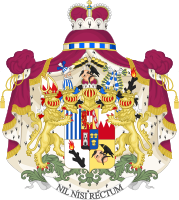
1.Palais Schwarzenberg (Schwarzenbergplatz)
2. Palais Schwarzenberg (Neuer Markt)
3. Neuwaldegg Castle
Bohemia
[edit]| Name | Image | Location | Map | Comments |
|---|---|---|---|---|
| Krumlov Castle Krumau Castle |
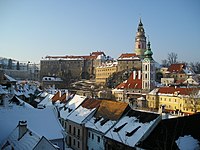
|
 Český Krumlov, South Bohemia |
Held from 1719 until the expropriation in 1947 UNESCO World Heritage Site One of the largest castles in the world | |
| Hluboká Castle Frauenberg Castle |
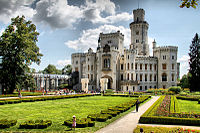
|
 Hluboká nad Vltavou, South Bohemia |
Acquired by Johann Adolf I of Schwarzenberg in 1661 Held until the expropriation in 1947 One of the finest examples of Neo-Tudor architecture in Historicism | |
| Vimperk Castle Winterberg Castle |
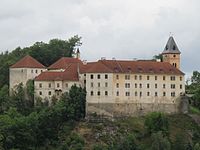
|
 Vimperk, South Bohemia |
Acquired in 1698 Held until the expropriation in 1947 | |
| Třeboň Castle Wittingau Castle |
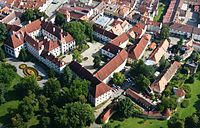
|
 Třeboň, South Bohemia |
Acquired in 1698 Held until the expropriation in 1947 | |
| Protivín Castle | 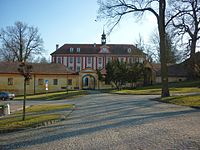
|
 Protivín, South Bohemia |
Acquired in 1711 Held until the expropriation in 1947 | |
| Kratochvíle Castle Kurzweil Castle |
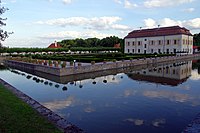
|
Netolice, South Bohemia | Inherited in 1719 from the Princes of Eggenberg Held until the expropriation in 1947 | |
| Červený Dvůr Castle Rothenhof Castle |

|
 Chvalšiny, South Bohemia |
Inherited in 1719 from the Princes of Eggenberg Held until the expropriation in 1947 | |
| Borovany Castle Forbes Castle |
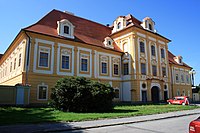
|
 Borovany, South Bohemia |
Acquired in 1789 in exchange for the Dominion of Vlčice (German: Wildschütz) Held until the expropriation in 1947 | |
| Dříteň Castle Zirnau Castle |
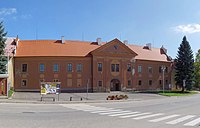
|
 Dříteň, South Bohemia |
Acquired in 1698 Held until the expropriation in 1947 | |
| Drslavice Fortress Drislawitz Fortress |
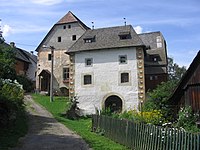
|
Drslavice, South Bohemia | Acquired in 1698 Held until the expropriation in 1947 | |
| Kestřany Castle Kesterschan Castle |
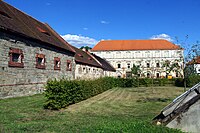
|
 Kestřany, South Bohemia |
Acquired in 1700 Held until the First Land Reform in 1924 | |
| Old Libějovice Castle | 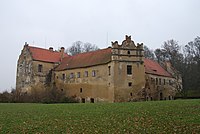
|
 Libějovice, South Bohemia |
Acquired in 1801 Held until the expropriation in 1947 | |
| New Libějovice Castle | 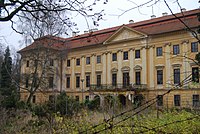
|
 Libějovice, South Bohemia |
Acquired in 1801 Rebuilt 1816 – 1817 Held until the expropriation in 1947 | |
| Ohrada Castle Wohrad Castle |
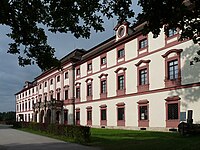
|
 Hluboká nad Vltavou, South Bohemia |
Built 1708 – 1713 Held until the expropriation in 1947 | |
| Chýnov |  Chýnov, South Bohemian Region |
Acquired in 1719 Held until the expropriation in 1947 | ||
| Postoloprty Postelberg Castle |
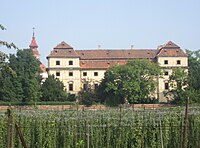
|
 Postoloprty, North Bohemia |
Acquired in 1692 Held until the expropriation in 1947 | |
| Nový Hrad Neuschloß Castle |
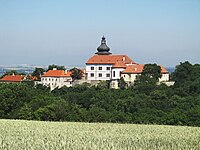
|
 Jimlín, Ústí nad Labem Region |
Acquired in 1767 Held until the expropriation in 1947 | |
| Lovosice Lobositz Castle |
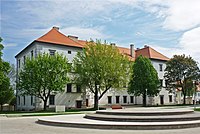
|
 Lovosice, Ústí nad Labem Region |
Acquired in 1783 Original seat of the Schwarzenberg Archives Held until the expropriation in 1947 | |
| Cítoliby Zittolieb or Zitolib Castle |
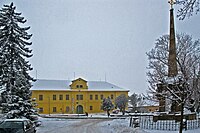
|
 Cítoliby, North Bohemia |
Acquired in 1803 Held until the First Land Reform in 1924 | |
| Domoušice Domauschitz Castle |
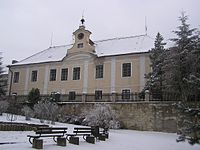
|
 Domoušice, North Bohemia |
Acquired in 1802 Held until the First Land Reform in 1924 | |
| Mšec Kornhauz Castle |
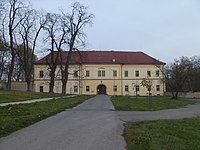
|
 Mšec, North Bohemia |
Held until the expropriation in 1947 | |
| Divice Fortress | 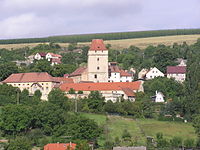
|
 Vinařice (Louny District), Ústí nad Labem Region |
Acquired in 1802 Held until the First Land Reform in 1924 | |
| Brodec Castle | 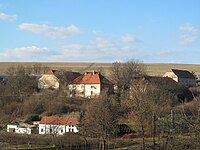
|
 Brodec (Louny District), Ústí nad Labem Region |
Acquired in 1802 Held until the First Land Reform in 1924 | |
| Dobrš Castle Dobrž Castle Dobersch Castle |
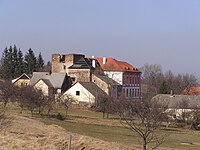
|
 Dobrš, South Bohemia |
Acquired in 1707 Sold in the 19th century. | |
| Vlčice Castle Wildschütz Castle |
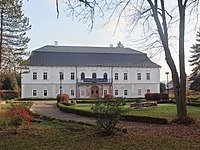
|
 Vlčice (Trutnov District) |
Acquired in 1675 Held until 1789 Exchanged for Borovany | |
| Břecštejn Castle Silberstein Castle |
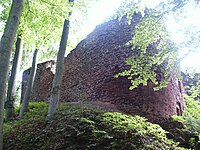
|
Hrádeček (Vlčice) | Acquired in 1675 Held until 1789 Exchanged for Borovany | |
| Orlík Castle Worlik Castle |
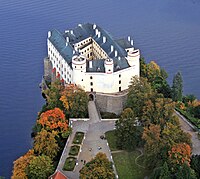
|
 Orlík nad Vltavou, South Bohemia |
Main residence of the Schwarzenberg Secundogeniture Restored in 1992 Held to present Publicly accessible | |
| Čimelice Castle | 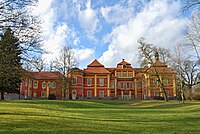
|
 Čimelice, South Bohemia |
Acquired in 1840 through the marriage of Karl II Schwarzenberg with Josefina Marie Wratislaw of Mitrovic Spring and summer residence of the Schwarzenberg Secundogeniture Restored in 1992 Held to present | |
| Karlov Castle | 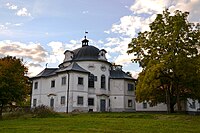
|
 Karlov (Smetanova Lhota), South Bohemia |
Restored in 1992 Held to present | |
| Varvažov Castle Warwaschau Castle |
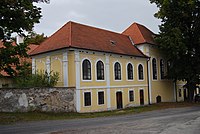
|
Varvažov, South Bohemia | Acquired in 1847 from the Sovereign Military Order of Malta Restored in 1992 Held to present | |
| Rakovice Castle | 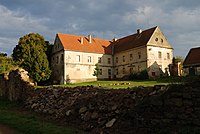
|
 Rakovice, South Bohemia |
Acquired in 1840 through the marriage of Karl II Schwarzenberg with Josefina Marie Wratislaw of Mitrovic Restored in 1992 Held to present | |
| Sedlec Castle Sedletz Castle |
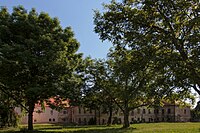
|
 Sedlec in the town of Kutná Hora, Central Bohemia |
Acquired in 1819 from the Cistercians Restored in 1992 Held to present | |
| Dřevíč Castle Grund Castle |
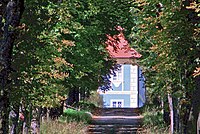
|
 Sýkořice, Central Bohemian Region |
Built by Joseph Wilhelm Ernst, Prince of Fürstenberg in the first half of the 18th century Sold by Maximilian Egon II, Prince of Fürstenberg to Czechoslovakia Acquired by Karel Schwarzenberg in 1991 Held to present | |
| Hunting lodge Tyrolský dům Tiroler Haus |
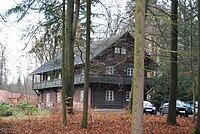
|
Květov, South Bohemia | Restored in 1992 Held to present | |
| Nový Dvůr Neuhof |
Obora u Cerhonic, South Bohemia | Acquired by Dr. Friedrich & Regula Schwarzenberg in the 1990's Held to present and main seat of Ferdinand Schwarzenberg | ||
| Tochovice Castle | 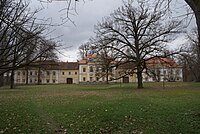
|
 Tochovice, South Bohemia |
Acquired in 1840 through the marriage of Karl II Schwarzenberg with Josefina Marie Wratislaw of Mitrovic Restored in 1992 Seat of Ernst Schwarzenberg's descendants Sold in 2022 | |
| Zbenice Castle | 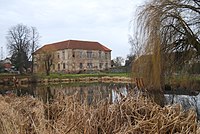
|
 Zbenice, Central Bohemian Region |
Acquired in 1805 through Karl I Schwarzenberg Held until 1948 | |
| Bukovany Castle Schloss Bukowan |
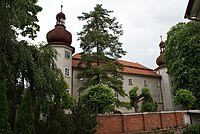
|
 Bukovany u Kozárovic, Central Bohemian Region |
Acquired in 1816 through Karl I Schwarzenberg Held until the First Land Reform in 1925 | |
| Zalužany Castle | 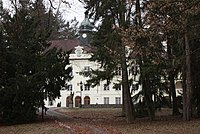
|
Zalužany, South Bohemia | Held until the First Land Reform in 1924 | |
| Osov Castle | 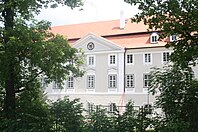
|
 Osov, South Bohemia |
Acquired in 1840.
Sold in 1927. | |
| Zvíkov Castle Zwingenberg Castle |
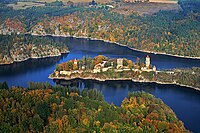
|
 Zvíkovské Podhradí, South Bohemia |
Held until 1948. In 1992 it was returned to the family and handed over to the care of the state.
Publicly accessible | |
| Starosedlský Hrádek Castle Altsattler Bürgel Castle |
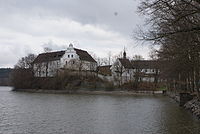
|
 Starosedlský Hrádek, Central Bohemia |
Held until 1948. | |
| Palais Schwarzenberg Schwarzenberský palác |
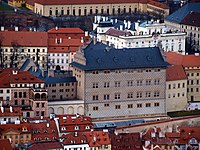
|
Prague |
Acquired in 1719 Held until the expropriation in 1947 Publicly accessible | |
| Palais Salm Salmovský palác Small Palais Schwarzenberg |
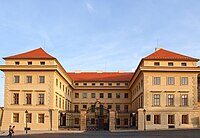
|
Prague |
Acquired in 1811 Held until the expropriation in 1947 | |
| Palais Deym Deymův palác |
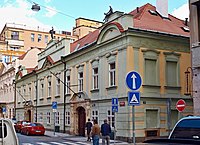
|
Prague |
Acquired in 1845 Prague seat of the Schwarzenberg Secundogeniture Held to present | |
| Palais Bissing Bissingenský palác Tatarkovic dům Schwarzenberský dům |
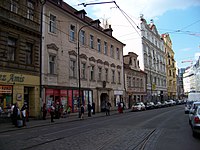
|
Prague |
Acquired in 1850 Consisting of two buildings: No. 90/17 (larger building with Schwarzenberg CoA) and No. 91/19. |
Military Units, Guards and Marksmen
[edit]Schwarzenberg Ulanen
[edit]Lancers, therefore cavalryman.
Schwarzenberg Guard
[edit]Grenadiers guard.
Murauer Bürgergarde
[edit]Civil infantery guard.
Fürtstl. Priviligierte Scheinfelder Böllerschützen
[edit]Marksmen unit.







